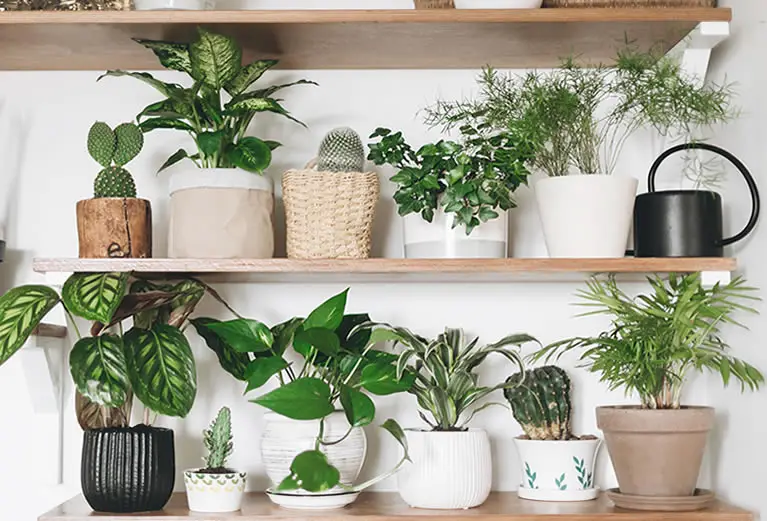Want to freshen up your indoor air and add a little life to your home—without fussing over complicated plant care? The good news is you don’t need a green thumb or a humid greenhouse to get cleaner air. There are several beautiful, low-maintenance houseplants that not only thrive indoors but also help remove harmful toxins from your environment.
These 10 air-purifying plants are perfect for beginners, busy folks, or anyone who wants to breathe a little easier—literally. Each one is resilient, rewarding, and known for improving indoor air quality while looking gorgeous in the process.
Let’s start with a true classic.
Table of Contents
- Snake Plant (Dracaena trifasciata)
- Peace Lily (Spathiphyllum)
- ZZ Plant (Zamioculcas zamiifolia)
- Spider Plant (Chlorophytum comosum)
- Rubber Plant (Ficus elastica)
- Golden Pothos (Epipremnum aureum)
- Areca Palm (Dypsis lutescens)
- Boston Fern (Nephrolepis exaltata)
- Aloe Vera
- Chinese Evergreen (Aglaonema)
- Final Thoughts
Snake Plant (Dracaena trifasciata)
The Snake Plant, also called Mother-in-Law’s Tongue, is practically bulletproof and one of the best air-purifying plants around.
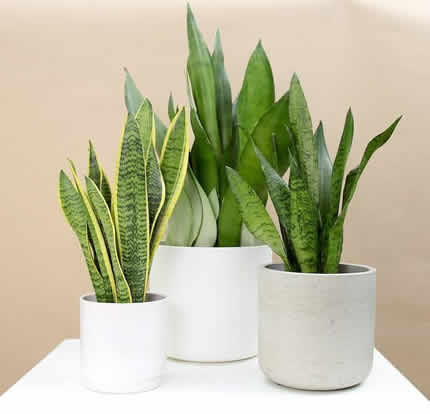
With its tall, upright leaves in striking green and yellow patterns, this sculptural beauty adds a bold touch to any room—and filters out toxins like formaldehyde, benzene, and xylene while it’s at it.
Basic Care Needs
Below are the basic care needs of this easy-care plant but if you want more detailed instructions read our article Snake Plant Care Made Easy.
Lighting needs
Snake Plants are incredibly adaptable and will grow in just about any light, from bright and sunny to dim corners.
They prefer indirect light but will tolerate low light and even a little direct sun.
Just avoid moving them back and forth between extremes too quickly.
Soil and watering
Like all succulents, Snake Plants need well-draining soil—think cactus mix or a blend with perlite and coarse sand.
Water deeply, then let the soil dry out completely before watering again.
These plants are very drought-tolerant and would much rather be underwatered than overwatered.
Temperature and humidity
They’re happy in average room temperatures from 60°F to 80°F and don’t need added humidity.
In fact, they do great in dry air, making them perfect for winter heating season or low-moisture homes.
Best spot in the house
Snake Plants are perfect for just about any room, but they shine in bedrooms thanks to their unique ability to release oxygen at night.
They’re also ideal for offices, entryways, or any space where other plants might struggle.
Peace Lily (Spathiphyllum)
Elegant, expressive, and famously low-maintenance, the Peace Lily brings a sense of calm and refinement to any room.
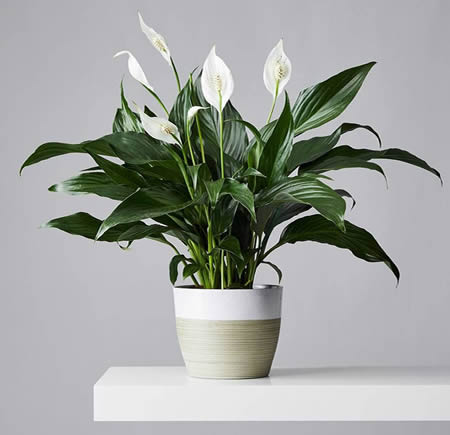
Its broad, dark green leaves and occasional white spathes (which look like delicate flowers) make it a beautiful decorative piece—and it’s also a powerhouse when it comes to purifying the air, filtering toxins like formaldehyde, benzene, and ammonia.
Basic Care Needs
Lighting needs
Peace Lilies prefer bright, indirect light, but they also tolerate low light exceptionally well.
In lower light, they may bloom less frequently, but they’ll still grow steadily.
Avoid direct sun, which can scorch the leaves and cause the tips to brown.
Soil and watering
Use a rich, well-draining potting mix and keep the soil evenly moist.
Water when the top inch of soil feels dry.
Peace Lilies are great at communicating their needs—they’ll droop dramatically when they’re thirsty, then perk up within hours after a good drink.
Temperature and humidity
They prefer warm, stable indoor temperatures between 65°F and 80°F.
These plants thrive in higher humidity and can benefit from misting or being placed near a humidifier, especially during winter when indoor air tends to dry out.
Best spot in the house
Peace Lilies are perfect for living rooms, bedrooms, and especially bathrooms with good natural light, where the extra humidity helps them flourish.
They also make thoughtful additions to meditation corners or home offices thanks to their soothing presence.
ZZ Plant (Zamioculcas zamiifolia)
The ZZ Plant is sleek, sculptural, and famously low-maintenance—making it one of the most reliable plants for improving indoor air quality.
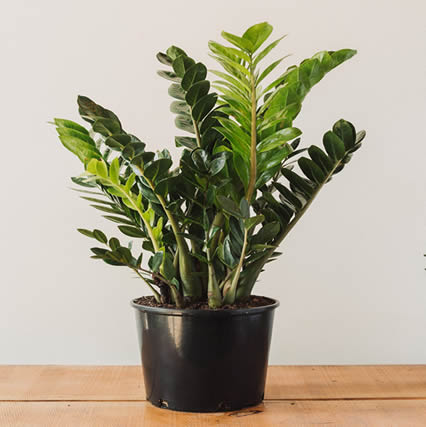
Its thick, waxy leaves not only look polished but also work quietly to remove pollutants like xylene and toluene from your environment.
Basic Care Needs
Below are the basic care needs of this easy-care plant but if you want more detailed instructions read our article ZZ Plant Care Guide.
Lighting needs
ZZ Plants thrive in bright, indirect light but are also completely unfazed by low-light conditions.
They’re one of the best choices for darker rooms, corners, or spaces without direct sunlight. Avoid placing them in full, harsh sun, which can scorch their glossy leaves.
Soil and watering
A fast-draining mix, like cactus or succulent soil, is ideal. Allow the soil to dry out completely before watering.
These plants store moisture in their rhizomes, so they can go for weeks without a drink and are extremely drought-tolerant.
Temperature and humidity
They prefer typical indoor temperatures between 60°F and 75°F and are totally unfussy about humidity.
They do just fine in dry air and aren’t bothered by household fluctuations.
Best spot in the house
ZZ Plants are perfect for offices, bedrooms, or entryways—anywhere with lower light and where you want a low-effort, modern plant that still works hard behind the scenes to clean the air.
Spider Plant (Chlorophytum comosum)
With its cheerful, arching leaves and trailing baby “spiderettes,” the Spider Plant adds a fresh, friendly feel to any room.
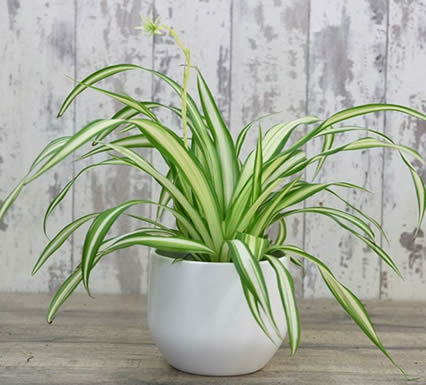
It’s a natural air purifier, especially effective at removing carbon monoxide, formaldehyde, and xylene from indoor air.
Basic Care Needs
Below are the basic care needs of this easy-care plant but if you want more detailed instructions read our article Spider Plant Care: How to Grow a Happy, Trailing Houseplant.
Lighting needs
Spider Plants do best in bright, indirect light but can also grow in medium light.
Direct sunlight may scorch their leaf tips, particularly in variegated varieties.
Soil and watering
Use a standard, well-draining potting mix and water when the top inch of soil feels dry.
They like regular watering but won’t mind if you occasionally forget.
If leaf tips turn brown, it may be due to overwatering, low humidity, or minerals in tap water.
Temperature and humidity
They’re happy in average home temperatures between 60°F and 80°F and prefer moderate humidity.
Misting occasionally or using filtered water can help prevent tip browning.
Best spot in the house
Spider Plants thrive in kitchens, bathrooms, or bright living rooms, especially when placed on shelves or in hanging baskets where their cascading leaves and baby plants can spill over beautifully.
Rubber Plant (Ficus elastica)
Bold, glossy, and full of presence, the Rubber Plant is a stylish indoor tree that also helps clean your air.
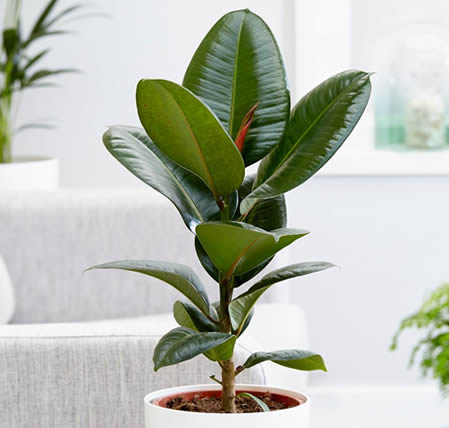
It’s particularly good at removing formaldehyde from household items like furniture, rugs, and cleaners—making it both functional and fabulous.
Basic Care Needs
Below are the basic care needs of this easy-care plant but if you want more detailed instructions read our article Rubber Plant (Ficus elastica): The 7 Care Requirements.
Lighting needs
Rubber Plants thrive in bright, indirect light.
They can tolerate medium light, but the leaves may grow more slowly and lose some of their deep color.
Avoid direct sunlight, which can cause scorching or fading.
Soil and watering
Use a rich, well-draining potting mix—something light with peat or compost and perlite.
Water when the top two inches of soil feel dry and let excess water drain out.
Be cautious not to overwater, as the roots are sensitive to soggy conditions.
Temperature and humidity
Keep it in a warm room between 60°F and 80°F, and away from cold drafts or sudden temperature shifts.
Rubber Plants prefer moderate humidity but will adapt well to normal household levels. Occasional misting keeps the foliage looking its best.
Best spot in the house
Ideal for living rooms, home offices, or open-plan spaces where it can grow tall and make a bold visual impact while quietly filtering the air around you.
Golden Pothos (Epipremnum aureum)
Golden Pothos, also known as Devil’s Ivy, is a trailing, vining plant with heart-shaped leaves streaked in golden-yellow.
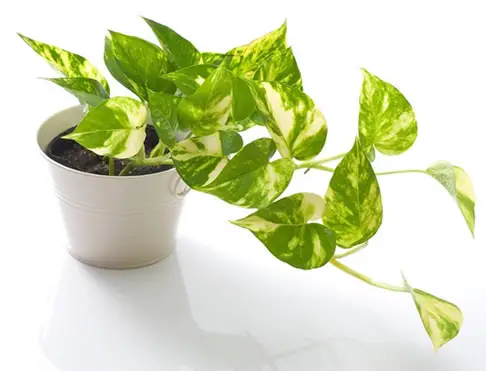
It’s incredibly easy to care for and one of the most effective plants for filtering formaldehyde, benzene, and toluene—especially around areas where adhesives and cleaners are used.
Basic Care Needs
Below are the basic care needs of this easy-care plant but if you want more detailed instructions read our article Golden Pothos Care: A Trailing Favorite That’s Almost Impossible to Kill.
Lighting needs
It thrives in bright, indirect light but tolerates lower light conditions well.
The variegation will be more vivid with good light, but it’ll still grow in dimmer spots. Avoid direct sun, which can scorch its leaves.
Soil and watering
Use a standard houseplant potting mix that drains well. Let the top inch or two of soil dry out before watering again.
It prefers consistent moisture but is forgiving if you occasionally forget to water.
Temperature and humidity
Golden Pothos likes temperatures between 60°F and 85°F and adapts to most indoor humidity levels.
It’s very tolerant of dry or humid air, making it a flexible option for any room.
Best spot in the house
Great for bedrooms, kitchens, or bathrooms, where it can hang from baskets or trail along shelves, all while purifying the air and brightening the room.
Areca Palm (Dypsis lutescens)
The Areca Palm is a graceful, feathery plant that instantly adds a tropical feel to your space—and it’s not just a pretty face.
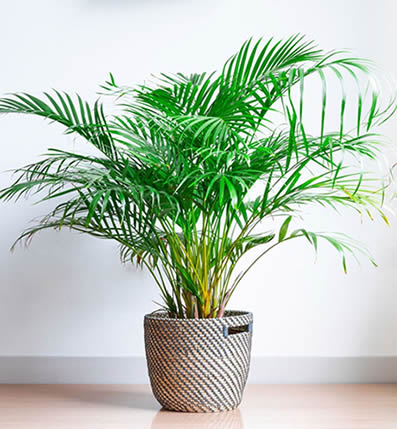
It acts as a natural humidifier and removes airborne toxins like benzene, carbon monoxide, and formaldehyde from your home.
Basic Care Needs
Below are the basic care needs of this easy-care plant but if you want more detailed instructions read our article on Areca Palm care.
Lighting needs
Areca Palms thrive in bright, indirect light. Too much direct sun can scorch the fronds, while too little light may lead to yellowing or slowed growth.
A lightly filtered spot near a sunny window is ideal.
Soil and watering
Use a light, well-draining potting mix and water when the top inch of soil feels dry.
These palms like evenly moist soil, but not soggy roots—so make sure your pot has good drainage.
Temperature and humidity
They grow best in warm temperatures between 65°F and 80°F and love higher humidity.
If the air is dry, especially in winter, consider misting regularly or placing it near a humidifier.
Best spot in the house
Areca Palms are perfect for living rooms and sunrooms where they can enjoy bright light and bring fresh, humidified air to shared spaces.
Boston Fern (Nephrolepis exaltata)
The Boston Fern is a lush, leafy plant known for its dense, arching fronds and its incredible ability to purify air—especially by removing formaldehyde and xylene.
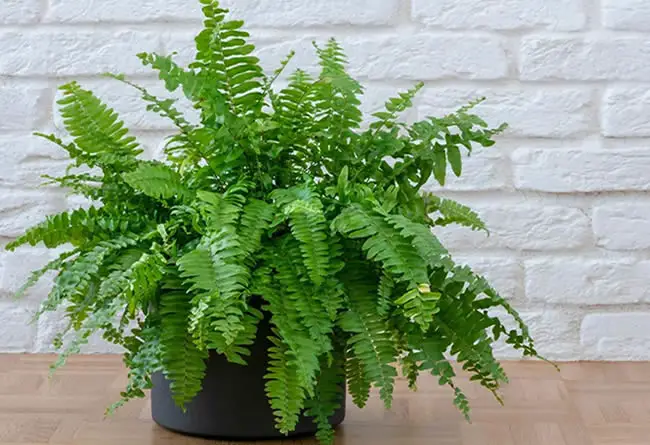
It’s also one of the best natural humidifiers on this list.
Basic Care Needs
Below are the basic care needs of this easy-care plant but if you want more detailed instructions read our article about Boston Fern care.
Lighting needs
This fern prefers bright, indirect light and will suffer in deep shade or strong, direct sunlight.
A filtered window with gentle light throughout the day is perfect.
Soil and watering
Use a moisture-retentive yet well-draining soil. Keep the soil consistently moist but not waterlogged.
Boston Ferns dislike drying out, so regular watering is key—especially in warmer months.
Temperature and humidity
They thrive in temperatures between 60°F and 75°F and absolutely love humidity.
Mist often, use a pebble tray, or keep it in a naturally humid space to prevent crispy fronds.
Best spot in the house
Boston Ferns are ideal for bathrooms with good light, where the natural humidity helps them flourish.
They also look gorgeous in hanging baskets in bright kitchens or covered porches.
Aloe Vera
Aloe Vera is best known for the soothing gel inside its fleshy leaves, but it’s also a quiet air-cleaning hero.
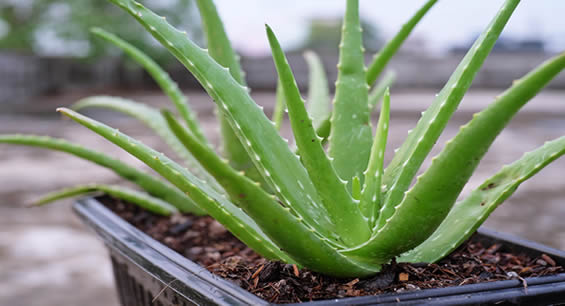
It helps remove formaldehyde and benzene—chemicals often found in cleaning products, paints, and synthetic materials—and looks great doing it.
Basic Care Needs
Below are the basic care needs of this easy-care plant but if you want more detailed instructions read our article Aloe Plant Care Basics For A Healthy Vibrant Succulent.
Lighting needs
This plant loves bright light and thrives on a sunny windowsill.
It can tolerate some direct sunlight, especially in the morning, but too much intense sun can cause the tips to turn brown.
Soil and watering
Aloe needs a very well-draining, sandy soil—cactus mix is ideal.
Let the soil dry out completely between waterings and always plant it in a pot with drainage holes.
Water thoroughly, but infrequently.
Temperature and humidity
Keep Aloe in a warm room between 60°F and 85°F.
It’s not fussy about humidity and actually prefers dry air, making it perfect for low-moisture homes.
Best spot in the house
Aloe is perfect for sunny kitchens, where it’s easy to access its gel for burns or cuts—and where it can quietly clear the air while basking in the light.
Chinese Evergreen (Aglaonema)
Chinese Evergreen is one of the most adaptable and undemanding houseplants, with lush, often variegated foliage and excellent air-purifying qualities.
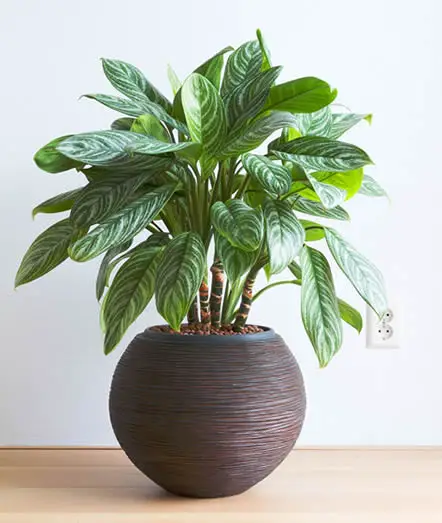
It filters toxins like benzene and formaldehyde and brings a pop of color to any room.
Basic Care Needs
Below are the basic care needs of this easy-care plant but if you want more detailed instructions read our article on Chinese Evergreen care.
Lighting needs
This plant does best in medium to low indirect light.
While some varieties with brighter variegation prefer more light, they all tolerate dim corners and artificial lighting remarkably well.
Soil and watering
Use a standard, well-draining potting mix and water when the top inch of soil is dry.
It likes consistent moisture but shouldn’t be allowed to sit in water.
Overwatering is the main issue to avoid.
Temperature and humidity
Chinese Evergreens prefer warm indoor temps between 65°F and 80°F and moderate humidity.
They’re sensitive to cold drafts, so keep them away from AC units or chilly windows in winter.
Best spot in the house
Ideal for bedrooms, offices, or shaded corners where light is limited.
It brings quiet color and clean air to even the darkest corners of your home.
Final Thoughts
Clean air, calm vibes, and low-maintenance care—these plants truly do it all.
Whether you’re looking to freshen up your bedroom, detox your living space, or simply add a little green magic to your home, these easy-care air-purifiers are a beautiful way to breathe better without the stress.
Start with one, or collect them all—your lungs (and your décor) will thank you. 🌿💨

